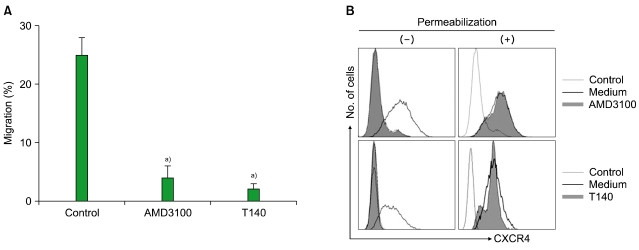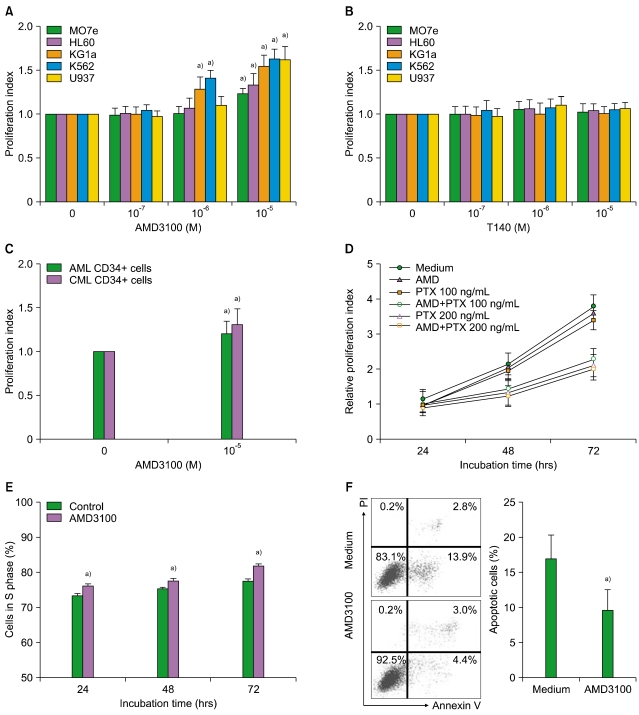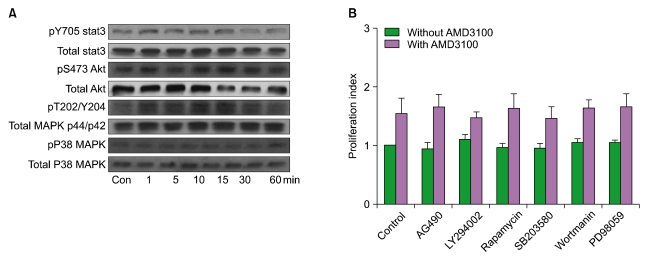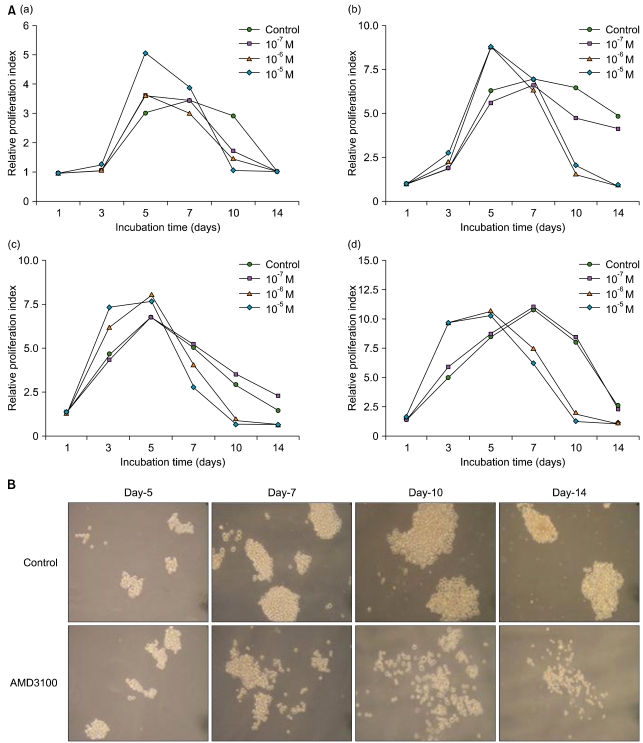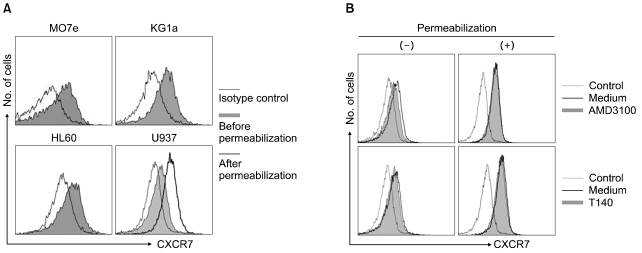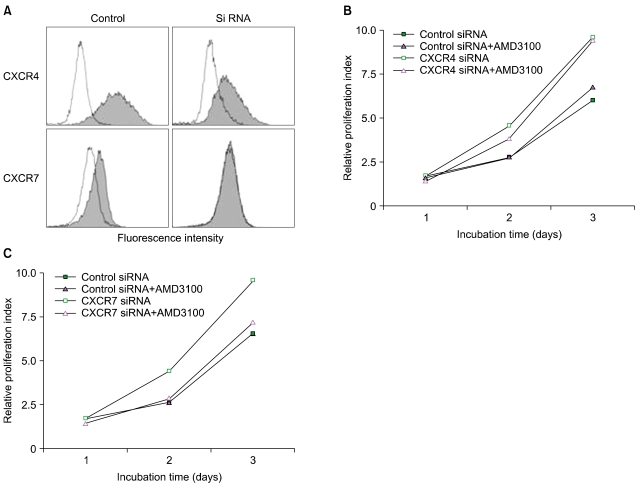Korean J Hematol.
2011 Dec;46(4):244-252. 10.5045/kjh.2011.46.4.244.
Differential effects of CXCR4 antagonists on the survival and proliferation of myeloid leukemia cells in vitro
- Affiliations
-
- 1Department of Medical Science, School of Medicine, Chungnam National University, Daejeon, Korea.
- 2Department of Internal Medicine, School of Medicine, Chungnam National University, Daejeon, Korea. deogyeon@cnu.ac.kr
- 3Department of Internal Medicine, Daejeon Saint Mary's Hospital, Daejeon, Korea.
- KMID: 2251985
- DOI: http://doi.org/10.5045/kjh.2011.46.4.244
Abstract
- BACKGROUND
Antagonists of CXC chemokine receptor 4 (CXCR4), including AMD3100, induce peripheral mobilization of hematopoietic stem cells and have been approved for clinical use. We explored whether the CXCR4 antagonists affected the survival and proliferation of myeloid leukemia cells in vitro.
METHODS
The effects of CXCR4 antagonists AMD3100 and T140 on the survival and proliferation of myeloid leukemia cell lines (U937, HL-60, MO7e, KG1a, and K562) as well as CD34+ cells obtained from patients with AML and CML were analyzed by flow cytometry by using annexin V and a colorimetric cell proliferation assay.
RESULTS
AMD3100, but not T140, stimulated the proliferation of leukemia cells in vitro in a dose-dependent manner for up to 5 days (~2-fold increase at a concentration of 10-5 M), which was not abrogated by pretreatment of the cells with pertussis toxin, but was attenuated by RNAi knockdown of CXCR7 transcripts. In contrast, AMD3100 induced a marked decrease in the cell numbers after 5-7 days. AMD3100, but not T140, induced phosphorylation of MAPK p44/p42. AMD3100 increased the number and size of leukemia cell colonies and reduced cell apoptosis during the first 5-7 days of incubation, but the phenomena were reversed during the later period of incubation.
CONCLUSION
The effects of CXCR4 antagonists on the proliferation of myeloid leukemia cells are not uniform. AMD3100, but not T140, exerts dual effects, initially enhancing and subsequently inhibiting the survival and proliferation of the cells in vitro.
Keyword
MeSH Terms
Figure
Reference
-
1. Peled A, Petit I, Kollet O, et al. Dependence of human stem cell engraftment and repopulation of NOD/SCID mice on CXCR4. Science. 1999; 283:845–848. PMID: 9933168.
Article2. Mohle R, Bautz F, Rafii S, Moore MA, Brugger W, Kanz L. The chemokine receptor CXCR-4 is expressed on CD34+ hematopoietic progenitors and leukemic cells and mediates transendothelial migration induced by stromal cell-derived factor-1. Blood. 1998; 91:4523–4530. PMID: 9616148.3. Durig J, Rosenthal C, Elmaagacli A, et al. Biological effects of stroma-derived factor-1 alpha on normal and CML CD34+ haemopoietic cells. Leukemia. 2000; 14:1652–1660. PMID: 10995013.4. Voermans C, van Heese WP, de Jong I, Gerritsen WR, van Der Schoot CE. Migratory behavior of leukemic cells from acute myeloid leukemia patients. Leukemia. 2002; 16:650–657. PMID: 11960346.
Article5. Majka M, Rozmyslowicz T, Honczarenko M, et al. Biological significance of the expression of HIV-related chemokine coreceptors (CCR5 and CXCR4) and their ligands by human hematopoietic cell lines. Leukemia. 2000; 14:1821–1832. PMID: 11021758.
Article6. Rombouts EJ, Pavic B, Lowenberg B, Ploemacher RE. Relation between CXCR-4 expression, Flt3 mutations, and unfavorable prognosis of adult acute myeloid leukemia. Blood. 2004; 104:550–557. PMID: 15054042.
Article7. Tavor S, Petit I, Porozov S, et al. Motility, proliferation, and egress to the circulation of human AML cells are elastase dependent in NOD/SCID chimeric mice. Blood. 2005; 106:2120–2127. PMID: 15941909.
Article8. Dommange F, Cartron G, Espanel C, et al. CXCL12 polymorphism and malignant cell dissemination/tissue infiltration in acute myeloid leukemia. FASEB J. 2006; 20:1913–1915. PMID: 16818471.9. Kollet O, Dar A, Shivtiel S, et al. Osteoclasts degrade endosteal components and promote mobilization of hematopoietic progenitor cells. Nat Med. 2006; 12:657–664. PMID: 16715089.
Article10. Peled A, Hardan I, Trakhtenbrot L, et al. Immature leukemic CD34+ CXCR4+ cells from CML patients have lower integrin-dependent migration and adhesion in response to the chemokine SDF-1. Stem Cells. 2002; 20:259–266. PMID: 12004084.11. Burger JA, Peled A. CXCR4 antagonists: targeting the microenvironment in leukemia and other cancers. Leukemia. 2009; 23:43–52. PMID: 18987663.
Article12. Donzella GA, Schols D, Lin SW, et al. AMD3100, a small molecule inhibitor of HIV-1 entry via the CXCR4 co-receptor. Nat Med. 1998; 4:72–77. PMID: 9427609.
Article13. Larochelle A, Krouse A, Metzger M, et al. AMD3100 mobilizes hematopoietic stem cells with long-term repopulating capacity in nonhuman primates. Blood. 2006; 107:3772–3778. PMID: 16439684.
Article14. Nervi B, Ramirez P, Rettig MP, et al. Chemosensitization of acute myeloid leukemia (AML) following mobilization by the CXCR4 antagonist AMD3100. Blood. 2009; 113:6206–6214. PMID: 19050309.
Article15. Zeng Z, Shi YX, Samudio IJ, et al. Targeting the leukemia microenvironment by CXCR4 inhibition overcomes resistance to kinase inhibitors and chemotherapy in AML. Blood. 2009; 113:6215–6224. PMID: 18955566.
Article16. Zhang WB, Navenot JM, Haribabu B, et al. A point mutation that confers constitutive activity to CXCR4 reveals that T140 is an inverse agonist and that AMD3100 and ALX40-4C are weak partial agonists. J Biol Chem. 2002; 277:24515–24521. PMID: 11923301.
Article17. Watanabe M, Matsuyama W, Shirahama Y, et al. Dual effect of AMD3100, a CXCR4 antagonist, on bleomycin-induced lung inflammation. J Immunol. 2007; 178:5888–5898. PMID: 17442973.
Article18. Kim HY, Hwang JY, Kim SW, et al. The CXCR4 antagonist AMD3100 has dual effects on survival and proliferation of myeloma cells in vitro. Cancer Res Treat. 2010; 42:225–234. PMID: 21253325.19. Tavor S, Eisenbach M, Jacob-Hirsch J, et al. The CXCR4 antagonist AMD3100 impairs survival of human AML cells and induces their differentiation. Leukemia. 2008; 22:2151–5158. PMID: 18769446.
Article20. Kalatskaya I, Berchiche YA, Gravel S, Limberg BJ, Rosenbaum JS, Heveker N. AMD3100 is a CXCR7 ligand with allosteric agonist properties. Mol Pharmacol. 2009; 75:1240–1247. PMID: 19255243.
Article21. Burns JM, Summers BC, Wang Y, et al. A novel chemokine receptor for SDF-1 and I-TAC involved in cell survival, cell adhesion, and tumor development. J Exp Med. 2006; 203:2201–2213. PMID: 16940167.
Article22. Liesveld JL, Bechelli J, Rosell K, et al. Effects of AMD3100 on transmigration and survival of acute myelogenous leukemia cells. Leuk Res. 2007; 31:1553–1563. PMID: 17403536.
Article23. Beider K, Begin M, Abraham M, et al. CXCR4 antagonist 4F-benzoyl-TN14003 inhibits leukemia and multiple myeloma tumor growth. Exp Hematol. 2011; 39:282–292. PMID: 21138752.
Article24. Tavor S, Petit I, Porozov S, et al. CXCR4 regulates migration and development of human acute myelogenous leukemia stem cells in transplanted NOD/SCID mice. Cancer Res. 2004; 64:2817–2824. PMID: 15087398.
Article25. Moepps B, Frodl R, Rodewald HR, Baggiolini M, Gierschik P. Two murine homologues of the human chemokine receptor CXCR4 mediating stromal cell-derived factor 1alpha activation of Gi2 are differentially expressed in vivo. Eur J Immunol. 1997; 27:2102–2112. PMID: 9295051.26. Balabanian K, Lagane B, Infantino S, et al. The chemokine SDF-1/CXCL12 binds to and signals through the orphan receptor RDC1 in T lymphocytes. J Biol Chem. 2005; 280:35760–35766. PMID: 16107333.
Article27. Miao Z, Luker KE, Summers BC, et al. CXCR7 (RDC1) promotes breast and lung tumor growth in vivo and is expressed on tumor-associated vasculature. Proc Natl Acad Sci U S A. 2007; 104:15735–15740. PMID: 17898181.
Article28. Meijer J, Ogink J, Roos E. Effect of the chemokine receptor CXCR7 on proliferation of carcinoma cells in vitro and in vivo. Br J Cancer. 2008; 99:1493–1501. PMID: 18854833.
Article29. Rajagopal S, Kim J, Ahn S, et al. Beta-arrestin- but not G protein-mediated signaling by "the decoy" receptor CXCR7. Proc Natl Acad Sci U S A. 2010; 107:628–632. PMID: 20018651.
- Full Text Links
- Actions
-
Cited
- CITED
-
- Close
- Share
- Similar articles
-
- Targeting the CXCL12/CXCR4 axis in acute myeloid leukemia: from bench to bedside
- The CXCR4 Antagonist AMD3100 Has Dual Effects on Survival and Proliferation of Myeloma Cells In Vitro
- Expression and functional roles of the chemokine receptor CXCR7 in acute myeloid leukemia cells
- Intraparenchymal Myeloid Sarcoma and Subsequent Spinal Myeloid Sarcoma for Acute Myeloblastic Leukemia
- Silencing of CXCR4 Inhibits Tumor Cell Proliferation and Neural Invasion in Human Hilar Cholangiocarcinoma

